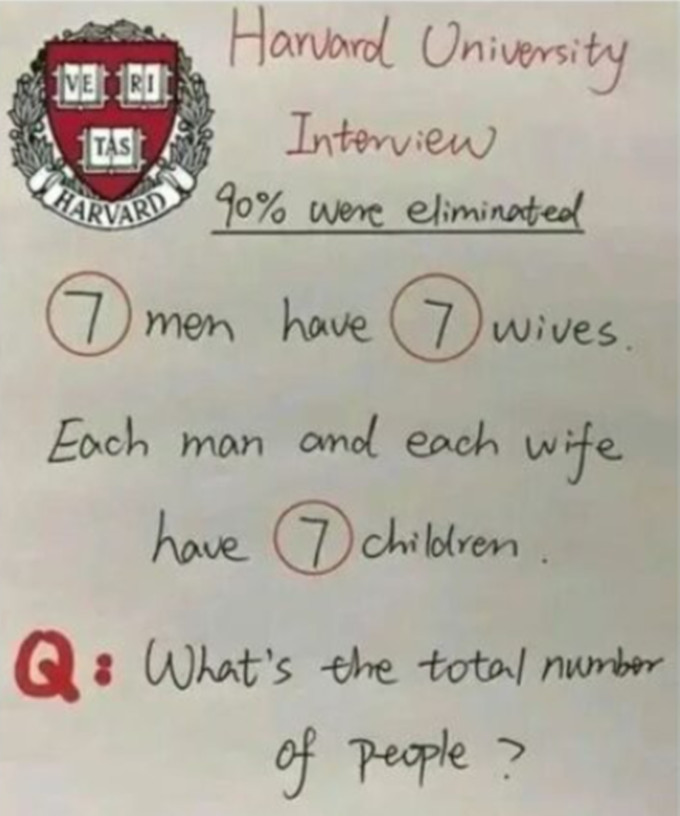Around 90% people are unable to crack this ‘Harvard University’ brain teaser
A brain teaser circulating on Instagram’s Threads has quickly become viral, with claims that even prospective Harvard students have been stumped by it.
The puzzle presents a deceptively simple scenario involving seven men, their wives, and their children. Yet, despite its straightforward premise, the majority of people — 90%, according to the post — struggle to find the correct answer, leaving many to wonder if there’s a trick hidden in the details.

Originally posted by Threads user @rombesk, the puzzle asks: “Seven men have seven wives. Each man and each wife have seven children. What’s the total number of people?”
 Source: Threads/@rombesk
Source: Threads/@rombesk
While it might seem like a simple calculation at first glance, the teaser has sparked debates and multiple interpretations, with many scratching their heads over what should be a straightforward math problem.
So, what makes this puzzle so perplexing?
Shreya Singh, principal data scientist, tells indianexpress.com, “People often overthink or get confused by brain teasers, even when they seem straightforward, due to several cognitive and psychological factors.” These include:
Complex Problem Representation: Brain teasers are designed to appear more complex, leading people to overcomplicate them and seek hidden meanings.
Cognitive Biases: Biases like the anchoring effect or confirmation bias can cause people to misinterpret problems, thinking they require special knowledge or focusing on incorrect assumptions.
Pressure and Anxiety: Fear of failure or making mistakes can create stress, clouding judgment and impairing clear thinking.
Over-reliance on Intuition: Teasers often exploit intuitive thinking, which can be misleading without a methodical approach.
The best approach to solving brain teasers that involve numbers and multiple groups of people
To solve brain teasers involving numbers and groups, Singh suggest using a strategic approach:
Read Carefully: Understand the problem by identifying key elements like numbers, groups, and the specific question asked. Avoid assumptions based on first impressions.
Simplify Information: Break the problem into smaller parts, listing each group and number separately. Visual aids like charts can clarify relationships.
Use Logical Steps: Solve step-by-step using basic math operations. Avoid unnecessary complexity.
Check for Misleading Details: Ignore extraneous information that doesn’t aid in solving the problem.
Verify the Answer: Double-check your calculations and logic to ensure the solution is accurate.
How can you solve this Harvard brain teaser?
Singh says, “In my view, the problem presents several ambiguities that can result in multiple interpretations based on the assumptions made. For instance, it is unclear whether each man has seven wives or if there are seven wives in total among all the men.”
Additionally, she explains, the problem does not specify whether the men, wives, and children are distinct individuals or if some of the children might be among the wives and men. “These uncertainties lead to different potential answers, making it challenging to determine a definitive solution.”
📣 For more lifestyle news, click here to join our WhatsApp Channel and also follow us on Instagram
Disclaimer: The copyright of this article belongs to the original author. Reposting this article is solely for the purpose of information dissemination and does not constitute any investment advice. If there is any infringement, please contact us immediately. We will make corrections or deletions as necessary. Thank you.
